Chicken, Christmas Eve, and the Change of Time
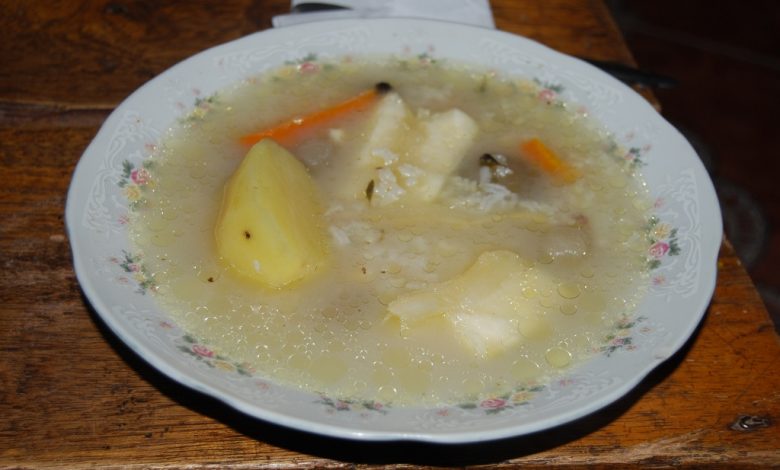
Three, two, one, the people of Cuzco count down on Christmas Eve, as if waiting for a space ship to blast off from Cape Cañaveral. They do this deep into the night, that magical time when the moon and stars rule the skies, a time when–though many people do not realize it– the machulas, the ancestors, can come out from the earth and till the fields.
Times of transition from day to night and from night to day are strongly marked even in today’s bustling modern city of Cuzco. The night is cold, and dark. It is a dangerous time when, if not careful, people can get sick as the cold enters into them.
Yet on this night, one of the most holy in the Christian calendar and one, as many observers write, with deep Incan roots, people stay up celebrating with family. They wait anxiously for midnight when they can celebrate Christ’s birth by putting the Child Emmanuel in his cradle in the crêche people set up in their homes waiting for him to arrive.
In English, Emmanuel sounds religious and foreign. In Spanish it does not sound so distant at all. Everyone knows someone named Manuel and someone named Jesus. The stories of Christ take, as a result, a grounding in ordinary normality, something not as easily for us Anglo Saxons. People in Cuzco refer to the Christ Child using a term of address very common in its streets and homes, “Niño Manuelito”.
With the word “niño”, or even more the word “papá”, father, people speak to little boys. So the Christ Child claims an intimacy and immediacy with these words, where he is both father and child, that is so unlike how we Anglos see him when the religious among us think of him as God. Even all the religious people in the United States who put up banners last night wishing him a happy birthday as if he were a child in their family or a neighbor boy still cannot create an immediacy so grounded in everyday language and experience.

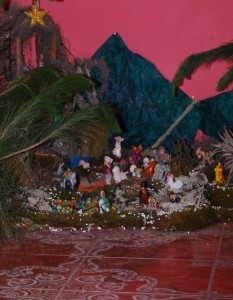
But it is more. Often the nativity scenes in Cuzco are built so that Christ is placed in a cradle within a mountain cave. Around the mountain an entire scene of life unfolds like in almost any village in the Peruvian highlands and real stones from the mountains are with him along with living moss and recently harvested grass and flowers.
Christ in this form is born, like the son and the ancestors, from the mountains called Apus or Lords, magnificent ones. Catholic catechists used this word, apu, as an honorific for Christ, but it never shakes its reference to the mountains. This is especially the case in a modern Cuzco where despite Internet and cable, cars and cell phones, the mountain Pachatusan still overlooks the city and everyone knows it is an Apu.
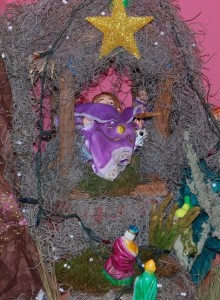
He is born like the sun, an image which the Christians also appropriated for their messiah. Though Christianized, a history still underlies this new sun (son, to use the inevitable English pun). The Incas were the children of the Sun and He, along with the earth, moon and stars, organized the ritual and economic life of the Empire. The Sun was not represented by only one figure, the sub burst one sees today, rather it was also represented in the figure of a grown man, the adult Sun of afternoon, slowly aging towards night, and as baby boy, the Sun of morning with its promise of life and growth.
It is not surprising that this image of the baby boy, the holy image of the new born Messiah of Christians should merge with the Inca baby Sun such that the indigenous people of Cuzco took special claim over the Christ Child as an object of devotion. This remains till today.
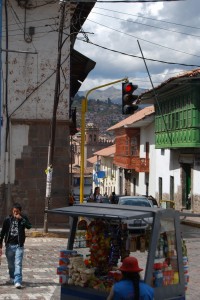
Rosario Olivas Weston describes how people would give gifts of “the most diverse sweets in miniature” to the Niño Manuelito, such as
little empanadas, little bizcochos, little braided roscas, little corn breads, and little suspiros [or sighs, made from egg whites and sugar]. At the same time little baskets and plates of carmel with figures of almond paste, for example, as well as a plate of Cusqueñan escabeche in miniature.
Olivas Weston laments that this custom has been lost. But the Christ child receives much attention and his “birth” (placement in the cradle) is surrounded with food and celebration in the family.
Some hours after night has settled in with its cold and frequently falling rain, cold and wet, the family gathers. It is often an extended family with grandchildren and hence cousins. They come to be together and await the magic moment, the zero hour.
They come together to talk, laugh, eat, and drink together, each an exchange of life and the warmth of being together like the warp and woof of a finely woven traditional cloth.
Before midnight a paneton, a massive mountain of fruited sweet bread comes out and is sliced. Everyone get a vertical piece of the massif along with a steaming cup of hot chocolate. Hot chocolate and Christmas are as Peruvian as the national anthem. But besides living a common national culture, in the shared sweetness and brightness of the fruit set in bread as well as the warmth of the mild stimulant that is chocolate, people consume a metaphor that transforms.
They add to the warmth of family around them a heat and sweetness that go inside to warm their bodies and selves and bring sensitivity and warmth to each and or each other.
After midnight and placing the Niño Manuelito in the manger, the family eats together. One by one they are served a steaming bowl of chicken soup, caldo de gallina (mature hen) and not pollo (young chicken). The chicken soup is traditional at Christmas.
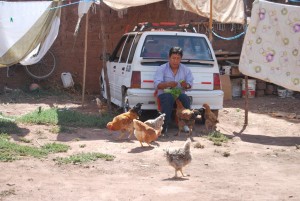
Called wallpa in Quechua, the word chicken has made analysts take pause. There is an indigenous word for chicken even though most suppose the bird came with the Spanish. And, that word is in the name of the last pre-Spanish emperor, Atahuallpa.
Linda Seligman, in a detailed study of the word writes “The extraordinary number of words and phrases in the Quechua lexicon that use the root wallpa confirm that the chicken is a highly complex and significant concept.” (p 146) She details the meanings as follows.
(1) God who creates or forms something anew, ot the inspired person who makes things slowly and well; (2) dividing something fairly and equally; (3) being a nuisance, interfering and unfairly passing judgement; (endearing oneself to one’s friends; (gallant and lavishly dressed men and warriors; all this along with meaning hen and rooster. The meanings, despite their diversity, all concern behavioral powers–positive and negative, human or supernatural — linked directly to authority and qualities of leadership.
Seligman relates wallpa to the creator god Viracocha and the other creator God the Sun , often blended, which were critical in Cuzco. Then she tells the following tale from rural Cusqueños such that “when contemporary Quechua speakers tell of their ancestors, they also speak of wallpa”. (p. 153)
Our Ancient Ancestors
When this time was beginning, it did not dawn for three days and nights. The Inca ancestor said, “when will the dawn come? When? What are we going to do: Well if the dawn is to come, it will come. And before long, it will seize all our things.” Thus he was sad.
While they were afflicted in this way, the rooster crowed for the first time.
“Already. Now the time of God, the Father, is going to end. The time of God the Son is going to begin.”
“When they were taking all their silver and their things to the mountains and breaking everything, the rooster crowed again.
“This is it. Soon it is going to dawn,: they said.
“When it reaches us, we are going to beat the sun,” they said. “We are goiong to murder the sun.”In that condition, after a while, the sun came out saying, “rij, rij.” How could it have come out with so much power for the first time! When the sun came out, the rooster crowed again. Now yes. The time of God the Father had ended. The time of God the Son, was already beginning. At that moment the sun dried up all those ancient ones. Some it took right there while others escaped to the jungle. (Gow and Condori 1976: 26)
Wallpa, Seligman argues, came to refer to a time of radical change, a pachacuti. In this, it is meaningful that wallpa, chicken, is consumed just after midnight on Christmas Eve, just after the Niño Manuelito is placed in his cradle in the mountain. Radical changes has arguably happened and a new time is dawning in a deft combination of Christianity with indigenous realities.
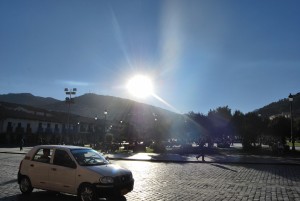
Following the soup, people eat roast chicken, or chicken in some other form, although increasingly people with money are serving turkey following the influence of the coast. Traditionally the chicken is accompanied by a pastel de fideo, a baked dish of noodles with olives and cheese and fluffy potatoes, papas harinosas. They also enjoy wine or champaigne.
But most importantly, before they people sit down to eat. Just after the stroke of midnight, they exchange hugs and kisses, sealing the way that social ties move them across this divide of time and change.
On the twenty-fifth many people will take their Christ child to hear mass, and then will gather again for a Christmas dinner.
But for now, midnight is approaching. Three, two, one, and the entire sky breaks into light and sound. Fireworks, bottle rockets, and full exploding bursts fill the sky. Even though political leaders are concerned about safety, from seemingly every home in Cuzco fireworks fly into the sky and create a momentary dawn. Night is conquered and day will return.
References:
Rosalind Gow and Bernabé Condori, Kay Pacha, Cusco: Centro de Estudios Rurales Andinos, CBC, 1976.
Linda Seligman, The Chicken in Andean History and Myth: The Quechua Concept of Wallpa, Ethnohistory, 34:2:139-170, 1987.




